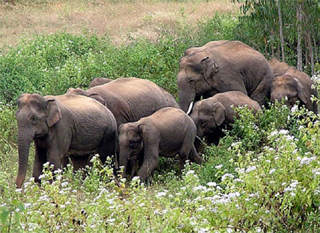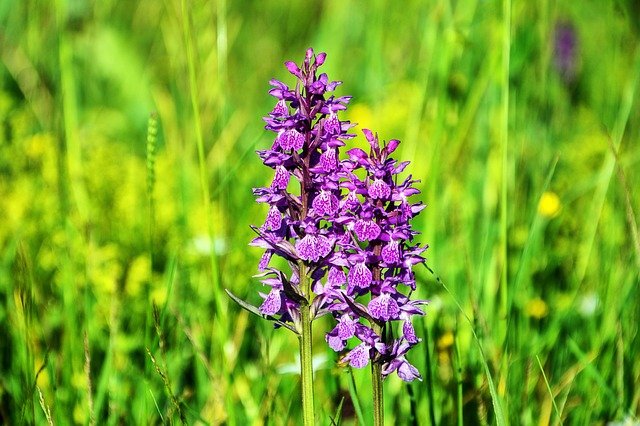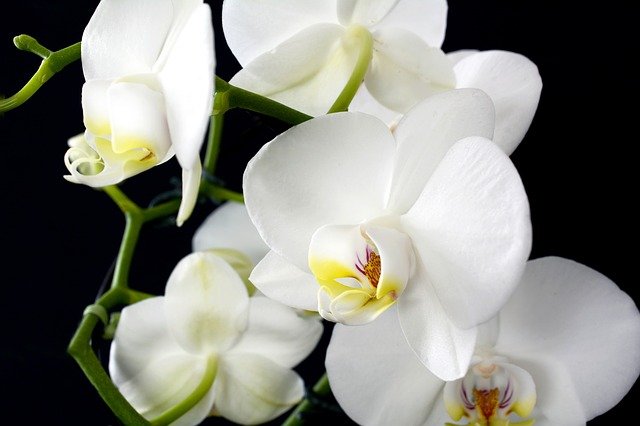Sessa Orchid Sanctuary is a 100 km2 protected area of India in the Himalayan foothills in Bhalukpong Forest Division of West Kameng District, Arunachal Pradesh. It conjoins Eaglenest Wildlife Sanctuary to the southwest. It is a part of the Kameng Protected Area Complex (KPAC), which is an Elephant Reserve. See map.
The department of Environment & Forests has developed trekking routes for visitors to enjoy the natural habitats of orchids. There are deep gorges and valleys, high peaks and rugged terrain that are rewarding for nature lovers and adventure tourists. A nursery includes representative specimens of various orchid species of the sanctuary and a demonstration farm of Cymbidium hybrids for cut-flower production. This patch of forest provides ideal home for orchids with other component of the ecosystem of forest vegetation. The evergreen forest with its close canopy stands with pristine glory. This Sanctuary will provide scope for the researcher to know more about the biotic elements for their research. The flora and fauna including micro organisms play a definite role to create conditions in situ and ex-situ for the survival of future generations. It is endeavor to the entire nature lover to create a sentiment for the cause of conservation. There is one orchidarium at Tipi, which is engaged in the mission of conservation, protection and multiplication of orchids. As already discussed that the propagation and germination of orchid is so delicate that has always a risk factor. It is necessary to develop the knowledge and technology for its ex situ culture. The orchid centre a Tipi is playing a great role in this field. It has a nursery of orchids as well a tissue culture laboratory. It is a very intricate process and has different stages. The propagation also is done at this laboratory through the minute seeds creating an artificial media and condition for germination. Visit to this centre is really a meaningful both for learning and for exhibit. There are varieties of orchids like Cymbidium spp., Dendrobium spp., Erica spp., Aracus spp., Selogenia spp., Agrostophyllum spp. etc. the Cymbidium spp., is most costly and has a value in the international market comparing to Dendrobium spp. The floral axis of Dendorbium is tall and bears number of flowers. The inflorescence is fascinating and charming that gives the value of this variety. The main character of its flower is longevity, colour and the attraction.
Geography & climate
Sessa and Eaglenest together occupy a rough east-west rectangle with Sessa occupying the north-east quadrant. The Bhalukpong-Bomdila highway (and Pakke immediately beyond) are its eastern boundary. It is bounded to the north by the Tenga River valley. Altitude is 900 metres (2,953 ft) to 3,250 metres (10,663 ft). Sessa and Eaglenest ridges rise to 3,250 metres (10,663 ft) and 2,700 metres (8,858 ft) respectively and are the first major barriers to the monsoon as it moves north from the plains of Assam. These ridges get over 3,000 millimetres (120 in) of rain on the southern slopes and about 1,500 millimetres (59 in) on the northern slopes. Sessa sanctuary is drained by the Tippi Naala (Tippi river) which joins the Kameng river at Tippi village on the Bhalukpong-Bomdila highway. Topographic map
Sessa is part of the Kameng protected area complex (KPAC), the largest contiguous closed-canopy forest tract of Arunachal Pradesh, which includes Sessa, Eaglenest, Pakke, Nameri, and Sonai Rupai sanctuaries and associated reserved forest blocks. The Complex covers 3500 km2 in area and ranges from 100 metres (328 ft) to 3,300 metres (10,827 ft) 3300m in altitude. Sessa is in an area under claim of Chinese sovereignty, in the jurisdiction of Cuona County of Shannan Prefecture of the Tibet Autonomous Region.
Sessa is noted for the occurrence of more than 200 orchid species with 5 new and endemic species. Sub-tropical types include the genera Dendorbium, Bulbophyllum, Coelogyne, Eria, Phaius and Liparis. Ever since its creation in 1979, several field explorations have been carried out in the Sanctuary to study the distribution pattern of various orchid species. The area explored till date is shown in the map. These explorations have yielded 183 species in 55 genera. Of these, 144 are epiphytes and 39 terrestrial including 6 saprophytic. A complete list of the orchids recorded from here is given in Table 1. Some new, rare, and ornamental species are illustrated. The sanctuary is unique in having 7 endemic species of saprotrophic orchids. 12 rare species of different families were found in one study of the area. Sessa
Orchid Sanctuary has a complex topography with deep valleys and hills ranging between an altitude of 6000 m and 3076 m. Two high rising peaks (3076 m and 3075 m) form a ridge near the middle of the Sanctuary and these are surrounded by a number of lesser hill formations with heights varying from 1400 m to 2902 m. A number of rivers and rivulets, originating from here, render the atmosphere wet and humid and add to the beauty of the landscape through numerous waterfalls. All the hills, here, are densely covered with a variety of tropical, and alpine vegetation. The Sanctuary receives almost continuous rainfall from April to October. During the winter months (November and February), the higher peaks of the Sanctuary experience snow fall. In the Sub tropical zone, Altingia exelsa, Michelia champaca, M. oblonga, Schima wallichii, Syzygium cummuni, Englehardtia spicata, Litsaea spp, and Cinnamomum sp. are some of the common tree species. These harbour a variety of orchids. Ferns, mosses and bamboos comprise the ground growing vegetation.
In the temperate zone, trees of Quercus and Rhododendron from the main vegetation. The trunks and branches of these trees support a thick growth of different species of mosses. In the alpine zone, the dominant woody species are those of Tsuga, Cedrus, Betula, Populus and bamboos
Orchid Research and Development Centre
In 1979 the Government of Arunachal Pradesh established the Orchid Research and Development Centre (ORDC) at Tipi, and the Sessa Orchid Sanctuary 20 km away. The ORDC is actively engaged in exploration and collection of Orchid species, cultivation in orchidaria and gardens for their taxonomic study, conservation of rare and endangered species, creation of germplasm collections and multiplication of rare species through tissue culture techniques. The ORDC discovered the new species: Biermannia jainiana, Cleistoma tricallosum, Dendrobium kentrophyllum, Epipogium sessanum, Eria jengingensis, Eria lohitensis, Gastrodia arunachalenisis and Herminium longilonbatum.
Conservation
The Critical Ecosystem Partnership Fund (CEPF), a consortium of major international and regional organizations, has identified the Eastern Himalayan region around Arunachal Pradesh (Nepal, Bhutan and all of North-East India) as a critical global biodiversity rich area deserving of conservation focus. They identified the North-Bank Landscape (i.e. north bank of Brahmaputra, extending up the Eaglenest and Sessa slopes) and the Tawang region as worthy of particular focus.
Sessa is within the Conservation International Himalaya Biodiversity Hotspot area. Birdlife International has designated Sessa and Eaglenest Sanctuaries as an Important Bird Area (IBA IN344), with Blyth’s Tragopan identified as a vulnerable species of the area.
Visitor information
Visitors may contact the DFO Pakke WLS Division, Seijosa, East Kameng District or The Range Officer (WL), Sessa Orchid Sanctuary, Sessa, West Kameng District or the Asst. Orchidologist, Tipi Orchid Center, Tipi, West Kameng District.





